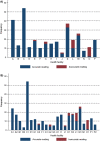Assessment of the accuracy of malaria microscopy in private health facilities in Entebbe Municipality, Uganda: a cross-sectional study
- PMID: 34090419
- PMCID: PMC8180171
- DOI: 10.1186/s12936-021-03787-y
Assessment of the accuracy of malaria microscopy in private health facilities in Entebbe Municipality, Uganda: a cross-sectional study
Abstract
Background: Although microscopy remains the gold standard for malaria diagnosis, little is known about its accuracy in the private health facilities in Uganda. This study evaluated the accuracy of malaria microscopy, and factors associated with inaccurate smear results at private health facilities in Entebbe Municipality, Uganda.
Methods: Between April and May 2018, all patients referred for a malaria smear in 16 private health facilities in Entebbe municipality were screened, and 321 patients were enrolled. A questionnaire was administered to collect demographic and clinical information, facility-based smear results were recorded from the participant's consultation notes, and a research slide was obtained for expert microscopy during exit interview. A health facility assessment was conducted, and information on experience in performing malaria microscopy was collected from all facility personnel reading smears and the data was linked to the participant's clinic visit.
Results: The test positivity rate of malaria parasitaemia was 15.0% by expert microscopy. The sensitivity, specificity and negative predictive value of the facility-based microscopy were high (95.8%, 90.1 and 99.2%, respectively). However; the positive predictive value (PPV) was low with 27/73 (63%) patients diagnosed with malaria not having the disease. Majority of the inaccurate results were from 2 of the 23 laboratory personnel reading the smears. The factors associated with inaccurate smear readings included being read by a technician; (1) who had less than 5 years' experience in reading malaria smears (adjusted Odds Ratio [aOR] = 9.74, 95% confidence interval [CI] (1.06-89.5), p-value = 0.04), and (2) who was examining less than 5 smears a day (aOR = 38.8, 95% CI 9.65-156, p-value < 0.001).
Conclusions: The accuracy of malaria microscopy in this setting was high, although one third of the patients diagnosed with malaria did not have the disease. Majority of the errors in smear readings were made by two laboratory personnel, with the main factor associated with inaccurate smear results being low experience in malaria microscopy. In-service training may be sufficient to eliminate inaccurate smear results in this setting, and these private facilities would be ideal model facilities to improve the quality of malaria microscopy in Uganda especially in the public sector where accuracy is still poor.
Keywords: Accuracy; Diagnosis; Malaria; Microscopy; Private health facilities.
Conflict of interest statement
The authors declare that they have no competing interests.
Figures

Similar articles
-
Malaria misdiagnosis in Uganda--implications for policy change.Malar J. 2009 Apr 16;8:66. doi: 10.1186/1475-2875-8-66. Malar J. 2009. PMID: 19371426 Free PMC article.
-
Evaluation of malaria microscopy diagnostic performance at private health facilities in Tanzania.Malar J. 2019 Nov 26;18(1):375. doi: 10.1186/s12936-019-2998-1. Malar J. 2019. PMID: 31771572 Free PMC article.
-
Determinants of malaria testing at health facilities: the case of Uganda.Malar J. 2021 Dec 4;20(1):456. doi: 10.1186/s12936-021-03992-9. Malar J. 2021. PMID: 34863172 Free PMC article.
-
Low quality of routine microscopy for malaria at different levels of the health system in Dar es Salaam.Malar J. 2011 Nov 2;10:332. doi: 10.1186/1475-2875-10-332. Malar J. 2011. PMID: 22047131 Free PMC article.
-
Multi-method assessment of patients with febrile illness reveals over-diagnosis of malaria in rural Uganda.Malar J. 2016 Sep 7;15(1):460. doi: 10.1186/s12936-016-1502-4. Malar J. 2016. PMID: 27604542 Free PMC article.
Cited by
-
Difference between Microscopic and PCR Examination Result for Malaria Diagnosis and Treatment Evaluation in Sumba Barat Daya, Indonesia.Trop Med Infect Dis. 2022 Jul 29;7(8):153. doi: 10.3390/tropicalmed7080153. Trop Med Infect Dis. 2022. PMID: 36006245 Free PMC article.
References
-
- WHO. World malaria R 2018. Geneva: WH, Organization. 2018. https://www.who.int/malaria/publications/world-malaria-report-2018/en/. Accessed 05 Mar 2019.
-
- Ministry of Health Uganda. Malaria operational plan FY. 2019. https://www.pmi.gov/docs/default-source/default-document-library/malaria.... Accessed 05 Sept 2019.
-
- Ministry of Health Uganda. Uganda clinical guidelines 2016. http://library.health.go.ug/publications/guidelines/uganda-clinical-guid.... Accessed 23 July 2020.
MeSH terms
Grants and funding
LinkOut - more resources
Full Text Sources
Medical
Miscellaneous

